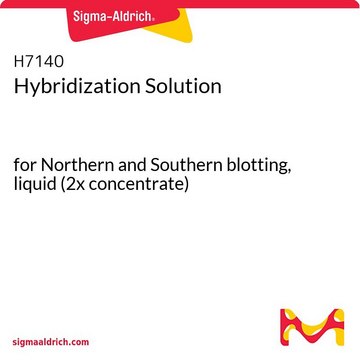Key Documents
H7033
PerfectHyb™ Plus Hybridization Buffer
for Northern and Southern blotting, solution
Synonim(y):
hyb buffer, hyb solution, hybridization solution, northern hybridization buffer, southern hybridization buffer
About This Item
Polecane produkty
Opis ogólny
Zastosowanie
Cechy i korzyści
- Fast and easy-to-use
- Up to 20x more sensitive than conventional buffers
- Doesn′t require blocking steps
- Compatible with neutral and positively-charged membranes
- Compatible with chemiluminescent, colorimetric , and DIG detection assays
- Compatible with radioactive and non-radioactive probes
- Compatible with single or double-stranded DNA, RNA, and oligonucleotide probes
Inne uwagi
Informacje prawne
zastąpiony przez
Kod klasy składowania
12 - Non Combustible Liquids
Klasa zagrożenia wodnego (WGK)
WGK 2
Temperatura zapłonu (°F)
Not applicable
Temperatura zapłonu (°C)
Not applicable
Certyfikaty analizy (CoA)
Poszukaj Certyfikaty analizy (CoA), wpisując numer partii/serii produktów. Numery serii i partii można znaleźć na etykiecie produktu po słowach „seria” lub „partia”.
Masz już ten produkt?
Dokumenty związane z niedawno zakupionymi produktami zostały zamieszczone w Bibliotece dokumentów.
Klienci oglądali również te produkty
Protokoły
Poznaj podstawy blottingu Northern i Southern, wraz z protokołami i aplikacjami do przenoszenia makrocząsteczek na nośniki membranowe.
An introduction to both Northern and Southern blotting, popular methods for the transfer of macromolecules to membranous support. This article also offers a Southern blot protocol and a northern blot protocol.
Nasz zespół naukowców ma doświadczenie we wszystkich obszarach badań, w tym w naukach przyrodniczych, materiałoznawstwie, syntezie chemicznej, chromatografii, analityce i wielu innych dziedzinach.
Skontaktuj się z zespołem ds. pomocy technicznej











